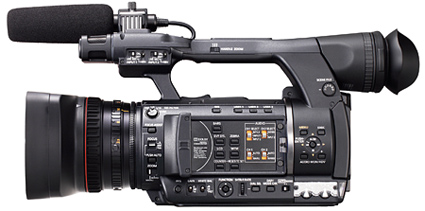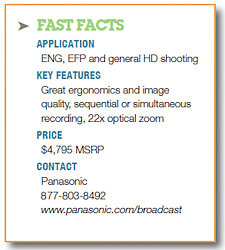Panasonic AG-AC160 Camcorder
The Panasonic AG-AC160 represents the company's latest entry into the 1/3-inch CMOS AVC-codec camera field—and what an entry. Panasonic has managed to find the sweet spot for cameras in this price range, and based upon my testing I strongly recommend it for photojournalists, documentary shooters, and, in general, anyone who is looking for maximum bang for the buck.

The Panasonic AG-AC160FEATURES
While all of the other qualities of a camera play a greater role in image quality and output, form factor is the first characteristic I look at. The AC160 may seem at first to have a bulky build, but all you have to do is just pick it up and you will see how ergonomically-pleasing this camera is. Its curved sides allow for easy hand-cradling. And it's amazingly lightweight. That could lead one to think the camera is flimsy; however, its magnesium body and high-impact plastic exterior lighten the load, while at the same time making it durable. Further, the camera's hand grip adjusts to your comfort position of choice. Also note that Panasonic provides three mounting points in different diameters on the camera's bottom for just about any mounting plate you might want to use with it.
And the camera's superb ergonomic design also extends to its controls. Most notable here are the menu button and associated multi-position switch with center selection button located toward the rear left of the camera. This makes changing menu options a snap; often without taking your eyes off either the viewfinder or LCD screen (more about that later). The Scene File rotary selection switch is located on the bottom of the handle, just to the left of the viewfinder. Again, it's easy to select.
But I've saved the best control feature for last. On the bottom left of the camera, there's a mode switch that allows you to toggle between shutter speed/angle, frame rate, and lock. So, without taking your eye off the image, you can change the shutter; however, and of greater importance for most users is the ability to dial variable frame rates between 2 and 60. (Of course, it's not possible to ramp speeds while recording.)
There's also another multi-position switch on the control area that makes life just a little easier. By using the function cursor key, you can change the camera's area for focus or iris. This is particularly important for auto-focus/auto-iris functions. In my testing, both of these worked without a glitch.
IN USE
During my evaluation of the AG-AC160, I got to discover some of the other features that Panasonic has managed to pack into this camera.
In addition to normal gain options, there's a "super gain" mode which will provide gain settings of 24 dB and 30 dB. However, please don't think that these "super gain" settings will produce a noiseless image. That much gain will definitely introduce noise into the equation, but there are times when shooting in extremely low-light conditions that shots demand it. (And sometimes where, in fact, the noise enhances the feeling of near darkness.) Speaking of noise, the camera does incorporate noise reduction circuitry, but not to the extent of its larger sibling, the AVCCAM/AVC-Intra HPX-250.
Yet another impressive feature available is the DRS (Dynamic Range Stretch) option. This applies a knee and gamma curve to extend the dynamic range in order to reduce blown highlights and enhance shadow detail. In my testing, I was unable to measure in terms of f-stops just how much the range was extended, but I'd estimate it's at least a full stop. This is significant when shooting scenes with wide highlight to shadow gradations.
Of course, there are both fully automatic and fully manual options. And unlike other earlier Panasonic cameras in this price range which I've both reviewed and owned, this one has a real iris ring rather than a dial on the camera control area. However, common to most cameras in this price range, neither focus nor iris rings have stops, and thus they turn infinitely. However, all the focus and iris information that you'd ever need is available through the viewfinder or LCD screen. I should note that the lens has a full 22x optical zoom for added versatility.
I have always loved that "Panny look" and the AC-160 follows in this tradition with that same Scene File structure with its Cine gammas and various matrix settings as found on the AC and HPX series models I've used. I have always been partial to the look of the Cine D gamma with its maximum dynamic range. And just like other Panasonic releases I've tested, the Scene Files can be altered, saved, recalled.
I should mention that the AC160 records to dual SDHC/SDXC cards, but with a great twist—it allows you to record to the cards sequentially, or simultaneously for back up, multiple distribution, or whatever other reason you may have for making multiple copies. Also, just as in prior Panasonic AVC releases, they refer to their variant on the AVC codec as AVCCAM, and it includes the same bit-rate options as prior releases: 6, 8, 17, 24 Mbps. This is switchable between 59.94 and 50 Hz to support all worldwide standards. And there's also a DV 720x480 resolution option.
Outputs available include HDSDI, HDMI, IEEE 1394 (DV only), USB 2.0. However, the HDSDI output is 8-bit only. This should be more than adequate even for broadcast work, although 10-bit is preferable for extensive grading and compositing operations. But to me, 8-bits rather than 10 is not really a deal breaker. And even if you're recording in HD resolutions, there's a built-in SD downconverter. In short, I found that Panasonic has thought of just about every possible shooting combination.
While the LCD screen is quite sharp and probably more than adequate for most users, I found it to be a bit small for my own tastes. But those multiple outputs I mentioned earlier make it possible to add a larger display screen if you like.
Panasonic includes options for both vectorscope and waveform monitor scopes. Personally, I didn't find a vectorscope that useful wile I'm shooting, but the option is there if you want it. If you like it, use it; if not, then you can just turn it off. The waveform monitor function provided is important to my style of shooting, as I like to judge exposure not just by eye, but by "zebras" and waveform monitor indications.
SUMMARY
Who would be best served by this camera? This is a great photojournalist camera. Its quality far exceeds what one would expect at this price point. The AVCCAM codec reads natively in Adobe Premiere CS5.5, Apple Final Cut Pro X and via AMA in Avid Media Composer. And Panasonic has just released a free AVCCAM import plug-in for FCP 7, which imports and transcodes to whatever flavor or ProRes the user selects. The codec is strong, yet compact, providing long record times on SDHC/SDXC cards. But be sure that you use Class 10 cards.
Documentary filmmakers will appreciate its lightweight and ergonomic form factor. Here again, long record times make certain that you won't miss the shot.
Because it has that "Panny look" the camera should intercut well as a B-cam in shoots where larger Panasonic cameras are employed.
The AG-AC160 combines quality, function and build in a remarkably affordable package. I heartily recommend it for shooters in the sub-$5,000 price range.
Ned Soltz is an independent video shooter, editor and producer, as well as consultant and general technology guru. He has more than 30 years experience in video, first learning to shoot on a "Sony Portapack" and editing on reel-to-reel tape. In addition to current production and consulting projects, he is a contributing editor for Digital Video magazine.

Get the TV Tech Newsletter
The professional video industry's #1 source for news, trends and product and tech information. Sign up below.
